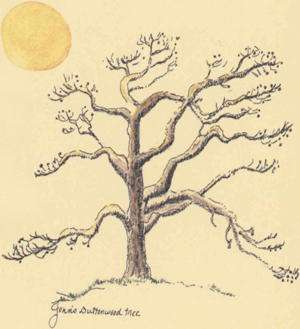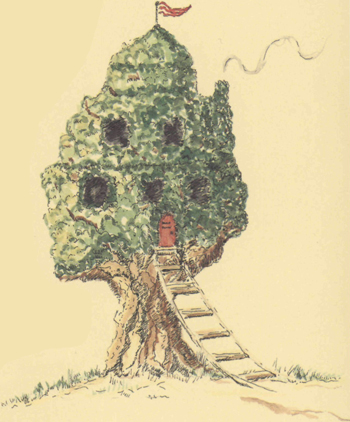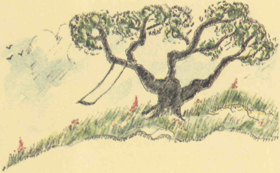
More than forty years ago a little boy with rosy cheeks and curly, cowlicked hair found his own tree. He didn’t know that it was a sycamore tree, over a hundred years old, the last of dozens which had once arched over Wildcat Creek.
The tree became the boy’s friend. When childhood problems overwhelmed him he ran to the tree, scrambled up its welcoming branches, and found comfort in its huge, sheltering presence. After a few years the one-sided conversations he had with his friend became part of a daily routine. The dependable old sycamore was always there to hear his wishes, dreams, and sorrows.
On the day his family left Indiana to move to California the little boy made one last trip to his friend. He hugged his tree and as he walked away, a strong wind stirred a piece of paper he had left in a hiding place. In childish writing the paper said, “I, John Arnold, love this tree.”

On the day I found out that I was pregnant, I bought a tree for my unborn son. During the months that Noah was growing inside me, the tree grew and flourished.
Afraid to plant the tree in the ground and leave it behind in a move, I planted it in a large terra cotta pot. To this day the Deodar cedar grows in a pot, gets fed regularly, and is talked to and nurtured like a child.
Give your child a birth tree. As the child grows, the tending of the tree can be a favored chore. The growth of the tree can be charted easily by tying a bit of colored string to the outermost tip of a branch each fall. During the spring and summer growth can be measured weekly.
Sunday mornings are my favorite time. I can curl up in bed and read and listen to the bird voices outside my window. I love to hear the quail coveys pattering across the roof—they sound like gentle rain.
Sunday mornings are when I do a lot of research from old garden and nature books. These are times of quiet discovery. Whenever I find a great garden poem, a story about children in the gardens and fields, or a story of a special garden, I feel as though I have uncovered a treasure.
Today I stumbled across an old etching of a Victorian garden. The etching depicted a huge catalpa tree. The tree had been pruned into the shape of a house—a true tree house! Windows and doors were simply cut through the outer leafy branches of the tree and the furniture was boughs. I could imagine half a dozen children eagerly climbing a rope ladder and entering the leafy bough house for an afternoon of sun-dappled dreaming and play.

My friend Georgie is in her early 80s and when I am with her, really, I think of her as a very, very young person. We were out in her garden last week admiring swaths of blooming, golden daffodils under her huge, centenarian oak tree.
As we stood eyeing the daffodils she looked up into her tree and said, “I really think every child should have a tree swing, don’t you?” I had to agree; I think a tree swing is one of the simplest and most wonderful garden pleasures.
“I used to love the freedom of swinging, and now that I think of it I really think that I NEED a swing in that tree. Yes, I NEED a swing,” Georgie said emphatically.
I have always heard that there is a bread-and-water type of necessity and then there is soul-food necessity. I think that Georgie hit upon a definite soul-food garden necessity—a swing. It could be a tire hanging from a tree, even a plain rope hanging Tarzan style, or a swing with a wood plank seat.
However you do it, remember what it felt like to have the wind rushing past your ears as you tried, pumping harder and harder, to reach the very spot where the green earth ended and the blue sky began.

I was wandering through the fragrant, meandering pathways at Lewis Mountain Herbs and Everlastings in Manchester, Ohio. As usual, my head was down, my eyes darting about at the variety of herbs and scented geraniums.
As I came to a Y in the path I looked up, trying to decide which fork to take, and gave a start of surprise. Ten feet in front of me was a lush, living gazebo of Ohio Melrose apple trees. The bough-canopied gazebo was punctuated by the straight trunks of the trees and festooned with slender arching branches. I headed for its sheltering circle.
I spent most of my afternoon sitting inside the gazebo surrounded by a curtain of shimmering leaves. A companionable brown towhee (we call them brown bettys in my family; the name seems to suit them) scratched through the soil, apple tree shadows playing across the ground and over her back.
To this day I think back to my afternoon in Ohio and realize what a haven that apple gazebo was for me. Imagine what it might mean to a child to find such a whimsical and playful space in the middle of an otherwise hands-off, grown-up garden.
The construction of the apple-tree gazebo was simple. John Lewis cultivated a circle and planted eight trees around its perimeter. Each one of the trees was sturdily staked to keep it straight. As the trees branched out, John pruned them to the shape he desired. Long branches were tied or wired to each other to form the arching canopy. Moderate trimming throughout the summer keeps the gazebo neat and inviting. I can’t wait to plant this playhouse!